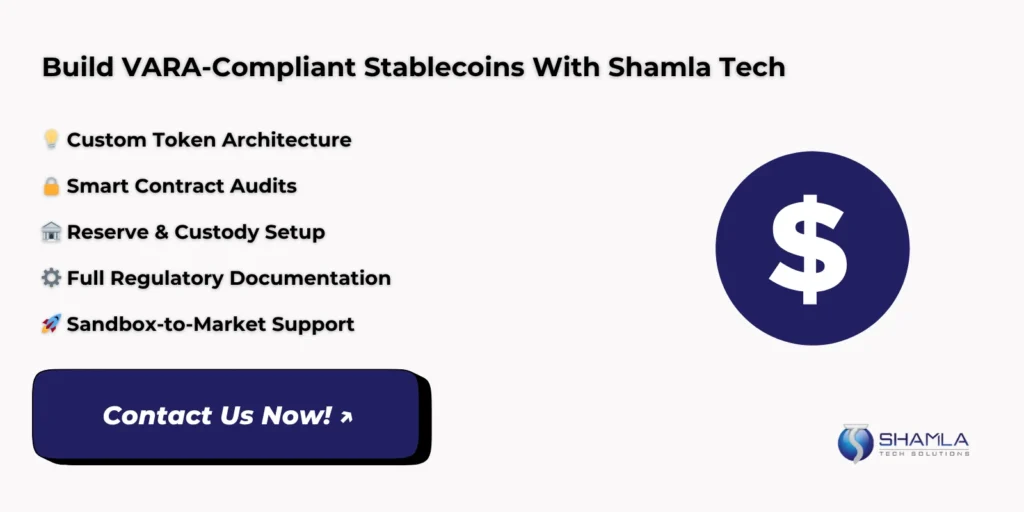The UAE stablecoin regulation landscape is setting a new global benchmark for digital asset compliance in 2026. For developers and businesses, this is the moment to build confidently within a framework that values both innovation and security.
The UAE has created a clear and supportive path for blockchain projects to issue regulated, asset-backed tokens that meet global trust standards. Partnering with a skilled Stablecoin Development Company ensures smooth integration of compliance from the start, avoiding delays and legal risks. As Stablecoin Regulation evolves, aligning your code, audits, and reserve mechanisms early will define long-term project success in the UAE.
Stablecoin Development in UAE: An Outlook
UAE’s clear rules and tech support make it a practical place to build stablecoins. The Central Bank of UAE stablecoin guidelines set simple reserve, custody, and issuance tests developers should all pass. UAE fintech regulations give sandboxes, API access to banks, and fast testing for proof-of-concept builds.
Teams should design contracts for 1:1 backing, audit hooks, and off-chain reserve proofs that auditors can read. Real Stablecoin Use Cases include low-cost remittances, instant merchant settlement, and tokenized trade finance. Following UAE stablecoin regulation from the start reduces legal friction and speeds live deployments. It also lowers costs, improves investor confidence and adoption.
Top 10 UAE Stablecoin Regulation Insights in 2026
Insight 1: VARA-Compliant Token Design Standards
VARA requires clear token design that shows how value is backed and how rules are enforced. Developers must include audit hooks, governance contracts with defined roles, and public disclosure templates that explain reserve logic. Aligning code to UAE stablecoin regulation from day one reduces review time, limits legal questions, and helps speed approval for live deployments and testable upgrade paths.
To be VARA compliant teams must publish regular attestations, provide auditable reserve records, and use signed attestations from custodians. Smart contracts need clear upgrade rules, multi-sig custody for reserves, and event logs that auditors can follow. Build automated reporting endpoints for regulators and keep readable disclosure files. This mix of code and paperwork cuts legal exposure and speeds regulator approval.
Insight 2: Central Bank of UAE Stablecoin Guidelines for Developers
The Central Bank of UAE stablecoin guidelines tell developers which token types are allowed and which are banned. Follow simple rules: no unbacked algorithmic coins, clear reserve proof, and fixed peg methods. These rules are part of UAE stablecoin regulation and mean teams must plan for on-chain and off-chain records, regular reports, and clear custody plans and daily audit-ready logs.
Developers must add reserve APIs that show real assets backing each token. Proofs must match on-chain totals and be verifiable by third parties. Use signed attestations from banks or custodians and build regulator-facing report endpoints. Keep records versioned with clear timestamps so audits are quick. Provide export tools, raw CSV feeds, and read-only admin panels for regulators with retention policies.
Insight 3: UAE Stablecoin Framework for Audit-Ready Code
Design smart contracts to record reserve links and show balances on demand. Include oracle feeds for price and reserve attestations, and add emergency pause and upgrade switches. Follow the UAE stablecoin framework so contracts match regulator checks and support UAE stablecoin compliance. Structure Fiat-Backed Stablecoins with clear on-chain links to off-chain accounts. Provide signed proofs for each reserve update daily.
Build lightweight on-chain events that mirror off-chain reserve moves to keep gas costs low. Store hashes of attestation files on-chain while keeping large records off-chain for auditors. Provide reconciler tools that match bank statements to token supply and expose CSV exports. Run regular third-party audits and publish summary attestations. Include clear error handling and replay protection.
Insight 4: Licensing Stack - From Sandbox to Production
Start in a sandbox to test flows and show regulators a working demo. Document architecture, threat model, and compliance hooks for auditors. Plan security audits, load tests, and smart contract reviews before applying for UAE stablecoin licensing. Work with local counsel to map technical docs to licence forms and compliance checklists for Crypto licensing in UAE and prepare operational runbooks.
After sandbox success, use evidence packages to apply for VARA or ADGM approval. Include test results, audit reports, and signed reserve attestations. Set up monitoring, alerting, and incident response playbooks before go-live. Follow UAE stablecoin rules on reporting cadence and keep a regulator contact for post-launch reviews. Run continuous compliance checks and automated ledger health reports and monthly legal refreshes.
Insight 5: Integrating Compliance Modules (AML/KYC)
Build AML and KYC into the stack so user onboarding ties to wallet and limits. Use risk scoring, sanctions lists, and watchlists in real time to flag bad actors. Automate case creation for suspicious flows and exportable evidence for regulators. These steps are core to UAE stablecoin compliance and meet UAE fintech regulations for traceability and retain user audit trails.
Set transaction limits and monitoring thresholds that match regulator guidance. Create batch reports for large transfers and automated filings for suspicious activity. Keep mapped user identities, timestamps, and token flow data ready for inspection. Design policy workflows to enforce freezes, reversals, and reporting that comply with UAE stablecoin laws. Train operations to run drills and rider tests for escalations monthly.
Insight 6: Custody, Asset Backing & Smart Contract Governance
Use multi-signature wallets so several trusted keys must approve moves. Keep reserves in separate accounts under a qualified custodian and avoid commingling. Design smart contracts to require pause and emergency controls tied to on-chain events. Log all approvals and export signed proofs for auditors. Rotate keys and document key custody policies with access lists and retention schedules for regulator review.
Follow UAE stablecoin rules by documenting custody flows and signer lists. Align custody design with UAE stablecoin licensing needs and include audit trails and access logs for regulators. Provide encrypted backups, incident procedures, and third-party attestation letters to prove reserve control. Maintain rotation schedules, segregation reports, reconciler scripts, and a public summary report for compliance reviews and exams annually audited.
Insight 7: Legal Framework and Code Ownership
Define code ownership and contributor rights with signed contributor license agreements. Keep detailed commit logs, release tags, and signed binaries that show code provenance. Use deterministic builds, checksum manifests, and reproducible build processes to link deployed binaries to source. Store legal records, test vectors, and build notes in secure archives to support traceability under UAE stablecoin regulation and public hashes.
Map release cycles and audit reports to the Legal framework for stablecoins in UAE. Keep proof of fixes, signed attestations, and versioned patch notes for every deployment. Set bug bounty scopes, rollback processes, and liability limits in service contracts. Align incident response, insurance terms, and governance with UAE fintech regulations and keep legal contacts and evidence packages for regulator review.
Insight 8: Cross-Border Payment Integration APIs
Build REST and message APIs that map token movements to bank rails and remittance partners. Use strong authentication, signed webhooks, and idempotent callbacks for settlement confirmation. Include batching, reconciliation endpoints, and replay protection so bank files match ledger changes. Design monitoring that verifies ledger health and settlement latencies to meet reporting expectations under Stablecoin regulation in UAE. Test with partners.
Create connectors for ERP and billing systems to automate settlement and ledger posting. Support ISO20022-like exports and CSV templates for bank reconciliation. Offer SDKs for merchants and PSPs to accept tokens and enable Stablecoin Payments via batch settlement. Build sample flows for payroll, remittance, and treasury.
Insight 9: CBDC vs Stablecoins — Developer Adaptation
Treat the UAE digital dirham as a permissioned ledger with strict access and rate limits. Design private stablecoins with bridges that control flows and require reconciled checkpoints. Map token identifiers, settlement rails, and identity proofs. Build adapters so private ledgers can push proof bundles to CBDC nodes and keep clear sync and dispute flows for CBDC vs Stablecoins and testing.
Follow Central Bank of UAE stablecoin guidelines on reporting, data retention, and custody reconciliation. Provide endpoint hooks for regulator queries and batch exports. Align data models, audit formats, and attestation stamps to the UAE stablecoin framework so every transfer has traceable proof. Document API rate limits, allowed data scopes, and privacy safeguards and include sample compliance reports for regulator review.
Insight 10: Partnering with a Stablecoin Development Company
Pick a Stablecoin Development Company that publishes security test results, audit reports, and past release notes. Look for Features of Stablecoin Development Company such as modular wallets, on-chain/off-chain reconciler, and reserve attestation services. Confirm they offer Stablecoin Smart Contract Development Services with formal verification, gas optimization, and upgrade patterns. Ask for references and sample code, and maintenance plans, SLAs now.
Ensure the partner has Stablecoin Development for Fintech Companies experience, including bank integrations, compliance modules, and custody workflows. Request a breakdown of Cost of Stablecoin Development covering audits, legal, custody setup, oracle fees, and cloud infra. Require an itemized roadmap, milestone payments, and delivery checklists. Negotiate SLA terms, support windows, upgrade or bug-fix turnaround times with clear acceptance tests.
Partner With Shamla Tech to Build VARA-Compliant Stablecoins
Shamla Tech is a Stablecoin Development Company that helps businesses build VARA compliant stablecoins for the UAE market. Their team follows the UAE stablecoin framework to design secure, transparent, and fully backed token systems. They handle everything from audit-ready smart contracts to reserve management and exchange integration.
Shamla Tech also guides clients through UAE stablecoin licensing and Crypto licensing in UAE to ensure every project meets legal and technical rules. With strong experience in blockchain, payments, and compliance, Shamla Tech makes it simple for fintechs and enterprises to launch safe, scalable, and regulator-approved stablecoins ready for 2026.
Conclusion
Building stablecoins in the UAE now means combining strong tech with clear compliance from the start. Developers must follow UAE stablecoin regulation for design, reporting, and custody. Embedding UAE stablecoin compliance inside contracts, audits, and APIs helps reduce future risks and review delays.
Teams should also stay updated with UAE fintech regulations as they evolve, ensuring systems remain secure, legal, and scalable. The projects that treat compliance as part of their architecture, not a later fix, will grow faster and face fewer operational limits. 2026 will reward teams that blend innovation, regulation, and technical discipline in every product decision.
Contact us today to build UAE-compliant Stablecoins with Shamla Tech!





